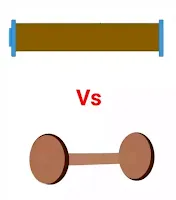Hello, friends today we are going to discuss shaft and axle. In which you will know what is the difference between shaft and axle.
Shaft and Axle both are playing the most important role in the manufacturing as well as the automobile industry.
Basically, Axle is one of the types of the shaft but it works and functions differently from the shaft which we will further know in detail.
Before knowing the difference between shaft and axle first of all we have to know what is shaft and axle and where to use them such that we can better understand the differences between them.
So without wasting time let's get started.
What is Shaft?
The shaft is a common and vital used machine element.
It is a rotating member, usually of a circular cross-section. The shaft may be hollow or solid.
The function of the shaft is to transfer the received power from one place to another, which is in the form of torsion (rotational rotation) and its second function is also that it supports the parts like pulleys, gears, etc.
Generally, it is a rod of a circular cross-section and as per requirement it is also made of other cross-sections (square, rectangular, etc.)
Shafts are made solid and hollow as per the requirement.
Shafts are also made to be pedestals so that the gears, pulleys, bearings, etc. are fixed on them.
The shaft is generally made up to 7 meters long and its diameter varies from 25 mm to 500 mm.
Materials of Shaft
Shafts are mostly made of mild steel, but they are also made of carbon steel and alloy steel such as nickel, chrome-nickel, chrome-vanadium, etc. for greater strength and use in special conditions.
Shafts are made by hot rolling and are later brought to a refined size by cold-drawing or by lathe and grinding.
The shaft materials properties should be good machinability and heat treated as well as high fatigue and resilience.
Large diameter shafts are made by forging.
What is Axle?
The axle is usually a non-rotating element of circular cross-section, which does not transmit any type of torque but is only used to support rotating machine elements such as wheels, pulleys, gears, etc.
Used to transmit bending moment only.
Since the axle is the stationary machine element, it does not transmit any power, speed, or torque therefore tangential or twisting is not subject to force or torque.
It is only subject to bending moment or axial force depending on the application.
It is commonly used in the automobile industry where the axle holds most of the car's load and is a vital component of the vehicle.
The car axle is the steel rod that connects the front and rear wheels of the car.
All cars are equipped with both side axles known as front and rear axles, which are used to turn the wheels when the driver accelerates the cars.
Materials of Axle
The materials used to make axles are steel or chrome-molybdenum steel as well as carbon steel.
 |
| Shaft Vs Axle |
What is the Difference Between Shaft and Axle?
There are the following 8 common differences between shaft and axle.
| Shaft | Axle |
|---|---|
| It is a rotating member. | It is a non-rotating member. |
| Its primary function is to transmit power. | Its primary function is to provide support to parts like a wheel, pulley, drum, etc. It does not transmit power. |
| It is subject to primary bending and torque. | It is subject to bending moment primarily due to transverse load. |
| Its design is more complex than that of the axle. | Its design is simpler than that of the shaft. |
| The cross-section of the shaft is usually circular because it gives minimum vibration and stress. | The cross-section of the axle may be different such as rectangular, square, circular, etc. |
| They are used for electric motors, I.C. Engine shaft, gear, etc. | They are used in cars, trucks, railway buggies, etc. |
| They may or may not be under normal load. | It is fitted into the housing by means of bearings. |
| The shaft is basically divided into two types, the first is the transmission shaft and the second is the machine shaft. | The axle is basically divided into three types, the first is the front axle, the second is the rear axle, and the third is the stub axle. |






1 Comments